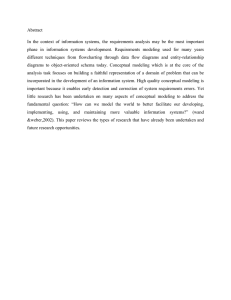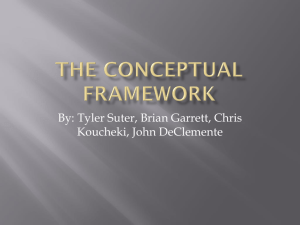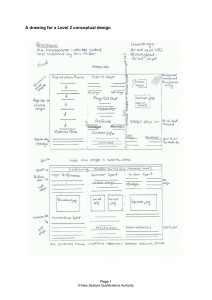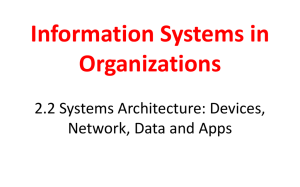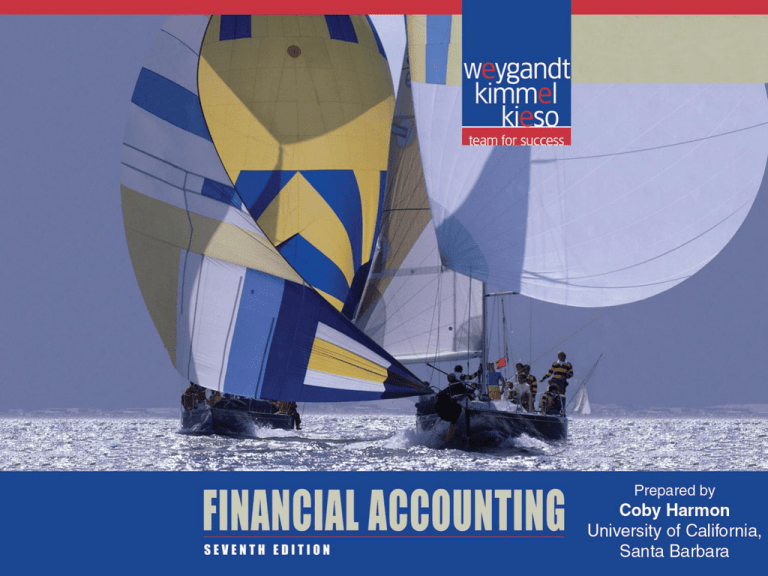
Chapter
7-1
Chapter
15
Accounting Principles
Financial Accounting, Seventh Edition
Chapter
7-2
Study Objectives
1. Explain the meaning of GAAP and identify the key items
of the conceptual framework.
2. Describe the basic objectives of financial reporting.
3. Discuss the qualitative characteristics of accounting
information and elements of financial statements.
4. Identify the basic assumptions used by accountants.
5. Identify the basic principles of accounting.
6. Identify the two constraints in accounting.
7. Explain the accounting principles used in international
operations.
Chapter
7-3
Accounting Principles
The
Conceptual
Framework of
Accounting
Objectives of
reporting
Qualitative
characteristics
Elements of
financial
statements
Operating
guidelines
Chapter
7-4
Constraints
in
Accounting
An
International
Perspective
Assumptions
Principles
Monetary unit
Revenue
recognition
Materiality
Differences
Cost-benefit
Uniformity
Expense
recognition
(matching)
Summary of
conceptual
framework
Economic
entity
Time period
Going
concern
Full
disclosure
Measurement
The Conceptual Framework of Accounting
Financial Statements
Various users
need financial
information
Balance Sheet
Income Statement
Statement of Retained Earnings
Statement of Cash Flows
Note Disclosure
The accounting profession
has attempted to develop
a set of standards that
are generally accepted
and universally practiced.
Chapter
7-5
Generally Accepted
Accounting
Principles (GAAP)
SO 1 Explain the meaning of GAAP and identify the
key items of the conceptual framework.
The Conceptual Framework of Accounting
Organizations Involved in Standard Setting:
Securities and Exchange Commission (SEC)
http://www.sec.gov/
Financial Accounting Standards Board (FASB)
http://www.fasb.org/
Chapter
7-6
SO 1 Explain the meaning of GAAP and identify the
key items of the conceptual framework.
The Conceptual Framework of Accounting
Conceptual Framework - “…a constitution, a coherent
system of interrelated objectives and fundamentals.”
FASB’s conceptual framework consists of the following:
Chapter
7-7
1.
Objectives of financial reporting.
2.
Qualitative characteristics of accounting
information.
3.
Elements of financial statements.
4.
Operating guidelines (assumptions, principles, and
constraints).
SO 1 Explain the meaning of GAAP and identify the
key items of the conceptual framework.
Conceptual Framework
Review:
A conceptual framework underlying financial
accounting is important because it can lead to
consistent standards and it prescribes the
nature, function, and limits of financial
accounting and financial statements.
True
Chapter
7-8
False
SO 1 Explain the meaning of GAAP and identify the
key items of the conceptual framework.
Conceptual Framework
Review:
A conceptual framework underlying financial
accounting is necessary because future
accounting practice problems can be solved by
reference to the conceptual framework and a
formal standard-setting body will not be
necessary.
True
Chapter
7-9
False
SO 1 Explain the meaning of GAAP and identify the
key items of the conceptual framework.
Conceptual Framework
Review:
What are the Statements of Financial Accounting
Concepts intended to establish?
a. Generally accepted accounting principles in
financial reporting by business enterprises.
b. The meaning of “Present fairly in accordance with
generally accepted accounting principles.”
c. The objectives and concepts for use in developing
standards of financial accounting and reporting.
d. The hierarchy of sources of generally accepted
accounting principles.
(CPA adapted)
Chapter
7-10
SO 1 Explain the meaning of GAAP and identify the
key items of the conceptual framework.
Conceptual Framework
Objectives of Financial Reporting
a) Useful to those making investment and credit decisions.
b) Helpful in assessing future cash flows.
c) Identify the economic resources (assets), the claims to
those resources (liabilities), and the changes in those
resources and claims.
Chapter
7-11
SO 2 Describe the basic objectives of financial reporting.
Conceptual Framework
Review:
According to the FASB conceptual framework, the
objectives of financial reporting for business
enterprises are based on?
a. Generally accepted accounting principles
b. Reporting on management’s stewardship.
c. The need for conservatism.
d. The needs of the users of the information.
(CPA adapted)
Chapter
7-12
SO 2 Describe the basic objectives of financial reporting.
Conceptual Framework
Question:
How does a company choose an acceptable accounting
method, the amount and types of information to
disclose, and the format in which to present it?
Answer:
By determining which alternative provides the most
useful information for decision-making purposes
(decision usefulness).
Chapter
7-13
SO 3 Discuss the qualitative characteristics of accounting
information and elements of financial statements.
Conceptual Framework
Qualitative Characteristics
Relevance – making a difference in a decision.
Predictive value
Confirmatory value
Faithful Representation
Complete
Neutral
Free from error
Chapter
7-14
SO 3 Discuss the qualitative characteristics of accounting
information and elements of financial statements.
Conceptual Framework
Enhancing Qualitative Characteristics
Comparability – Information that is measured and
reported in a similar manner for different
companies is considered comparable.
Consistency - When a company applies the same
accounting treatment to similar events from period
to period.
Chapter
7-15
SO 3 Discuss the qualitative characteristics of accounting
information and elements of financial statements.
Conceptual Framework
Review:
Relevance and faithful representation are the
two primary qualities that make accounting
information useful for decision making.
True
False
To be faithful representation, accounting
information must be capable of making a
difference in a decision.
True
Chapter
7-16
False
SO 3 Discuss the qualitative characteristics of accounting
information and elements of financial statements.
Conceptual Framework
Review:
Adherence to the concept of consistency
requires that the same accounting principles be
applied to similar transactions for a minimum of
five years before any change in principle is
adopted.
True
Chapter
7-17
False
SO 3 Discuss the qualitative characteristics of accounting
information and elements of financial statements.
Conceptual Framework
Elements of Financial Statements
“Moment in Time”
Assets
Liabilities
Equity
Chapter
7-18
“Period of Time”
Revenue
Expenses
Gains
Losses
SO 3 Discuss the qualitative characteristics of accounting
information and elements of financial statements.
Conceptual Framework
Operating Guidelines
Chapter
7-19
Assumptions
Assumptions provide a foundation for the
accounting process.
Monetary Unit
Economic Entity
Time Period
Going Concern
Chapter
7-20
SO 4 Identify the basic assumptions used by accountants.
Assumptions
Monetary Unit
Only transaction data capable of being expressed in terms of
money should be included in the accounting records of the
economic entity.
Chapter
7-21
SO 4 Identify the basic assumptions used by accountants.
Assumptions
Economic Entity
Economic events can be
identified with
a particular unit of
accountability.
Chapter
7-22
SO 4 Identify the basic assumptions used by accountants.
Assumptions
Time Period
The economic life of a business can be divided into
artificial time periods.
Chapter
7-23
SO 4 Identify the basic assumptions used by accountants.
Assumptions
Going Concern
The enterprise will continue in operation long enough
to carry out its existing objectives.
Chapter
7-24
SO 4 Identify the basic assumptions used by accountants.
Assumptions
Identify which basic assumption of accounting is best
described in each item below.
(a) The economic activities of FedEx Corporation
are divided into 12-month periods for the
purpose of issuing annual reports.
(b) Solectron Corporation, Inc. does not adjust
amounts in its financial statements for the
effects of inflation.
(c) Walgreen Co. reports current and noncurrent
classifications in its balance sheet.
(d) The economic activities of General Electric
and its subsidiaries are merged for
accounting and reporting purposes.
Chapter
7-25
Time Period
Monetary
Unit
Going Concern
Economic
Entity
SO 4 Identify the basic assumptions used by accountants.
Principles
Accounting principles dictate how economic
events should be recorded and
reported.
Revenue Recognition
Expense Recognition
Full Disclosure
Measurement
Chapter
7-26
SO 5 Identify the basic principles of accounting.
Principles
Revenue Recognition
- companies should
recognize revenue in the accounting period in which it is
earned.
Chapter
7-27
SO 5 Identify the basic principles of accounting.
Principles
Expense recognition - efforts (expenses) should be
matched with accomplishment (revenues) whenever it
is reasonable and practicable to do so. “Let the
expense follow the revenues.”
Illustration 15-9
Expense Recognition
Chapter
7-28
SO 5 Identify the basic principles of accounting.
Principles
Matching
Principle
Chapter
7-29
SO 5 Identify the basic principles of accounting.
Principles
Full Disclosure – Provided through financial
statements, notes to the financial statements, and
supplementary information.
Chapter
7-30
SO 5 Identify the basic principles of accounting.
Principles
Measurement– the value of an asset to be recorded
can use one of two principles. Selection of which to use
is usually a trade-off between relevance and faithful
representation. The two principles are:
•Cost
Principle; recording assets at their cost.
•Fair Value Principle; recording assets at the price
received to sell an asset or settle a liability.
Chapter
7-31
SO 5 Identify the basic principles of accounting.
Principles
Identify which basic principle of accounting is best
described in each item below.
(a) Norfolk Southern Corporation reports revenue
in its income statement when it is earned instead of
when the cash is collected.
Revenue
Recognition
(b) Yahoo, Inc. recognizes depreciation expense for
a machine over the 2-year period during which that
machine helps the company earn revenue.
Expense
Recognition
(c) Oracle Corporation reports information about
pending lawsuits in the notes to its financial
statements.
(d) Eastman Kodak Company reports land on its
balance sheet at the amount paid to acquire it, even
though the estimated fair market value is greater.
Chapter
7-32
Full
Disclosure
Measurement
SO 5 Identify the basic principles of accounting.
Constraints in Accounting
Constraints permit a company to modify
generally accepted accounting principles
without reducing the usefulness of the
reported information.
Materiality
Cost-benefit
Chapter
7-33
SO 6 Identify the two constraints in accounting.
Constraints in Accounting
Materiality
- an item is material if its inclusion or
omission would influence or change the judgment of a
reasonable person.
Chapter
7-34
SO 6 Identify the two constraints in accounting.
Constraints in Accounting
Cost-benefit- Weigh the costs of providing the
information against the benefits that can be derived
from using it.
Chapter
7-35
SO 6 Identify the two constraints in accounting.
Constraints in Accounting
What accounting constraints are illustrated by the
items below?
(a) Crimson Tide Corporation does not accrue a
contingent lawsuit gain of $650,000.
Cost-benefit
(b) Sun Devil Corporation expenses the cost of
wastebaskets in the year they are acquired.
Materiality
Chapter
7-36
SO 6 Identify the two constraints in accounting.
Summary of Conceptual Framework
Constraints
Chapter
7-37
An International Perspective
Problem: Numerous multinational corporations (MNCs)
who are companies that conduct operations in more than
one country where the accounting standard are not
always uniform from country to country.
The International
Accounting Standards
Board
(IASB), of which the United States is a member,
is working to obtain conformity in international
accounting practices.
Many companies (>7,100) around the world now use IASB
standards.
Chapter
7-38
SO 7 Explain the accounting principles used in international operations.
Copyright
“Copyright © 2010 John Wiley & Sons, Inc. All rights reserved.
Reproduction or translation of this work beyond that permitted
in Section 117 of the 1976 United States Copyright Act without
the express written permission of the copyright owner is
unlawful. Request for further information should be addressed
to the Permissions Department, John Wiley & Sons, Inc. The
purchaser may make back-up copies for his/her own use only
and not for distribution or resale. The Publisher assumes no
responsibility for errors, omissions, or damages, caused by the
use of these programs or from the use of the information
contained herein.”
Chapter
7-39

